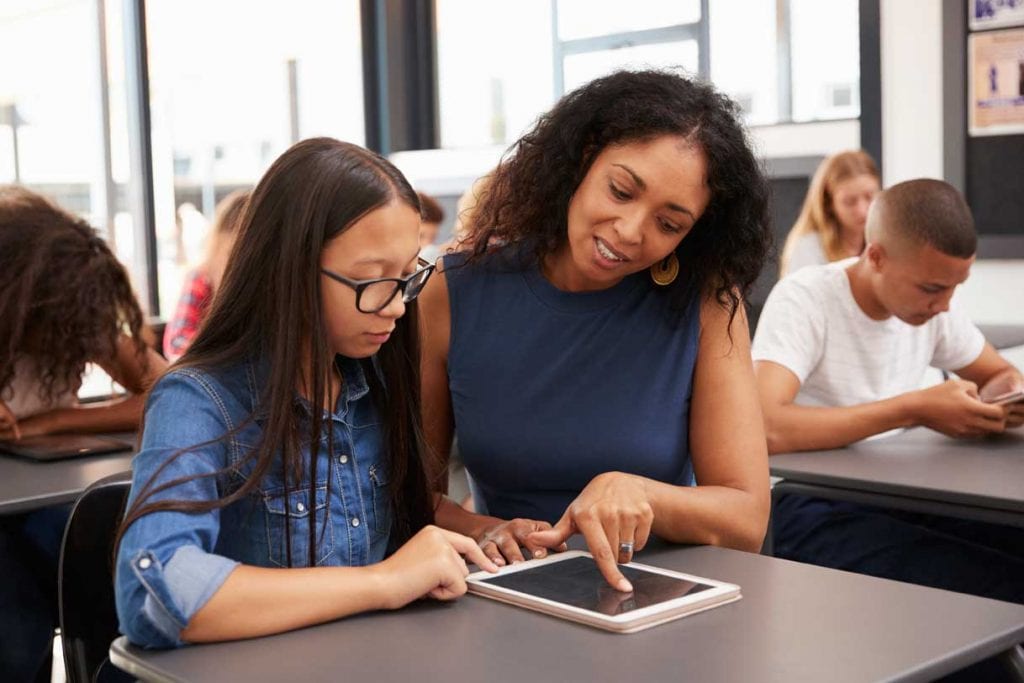The role of a teacher in regards to children’s development is obviously a very important one. Children look up to their teacher, but how they really see them may be different than you think. 1 in 5 children have a vision disorder, not knowing any differently, many of these children accept poor vision and other eye ailments as normal.
It can occur that children who have been misdiagnosed with a learning disability actually have a correctable vision problem. If these vision problems are left unchecked, serious long term effects can result.
As a teacher, you can play a major role in identifying potential vision problems.
Sight and learning.
Over 80% of a child’s learning is based on vision. When it comes to drawing, colouring, reading or following instructions, the eyes play a vital role. Vision is also hugely important when it comes to play.
If vision problems remain untreated, children that are full of potential are left lagging behind in learning and may become withdrawn or disruptive. If detected, these conditions can be corrected by an Optometrist or Ophthalmologist.
Children’s Eye Exam
One of the most important tests a young child can take is a comprehensive eye exam by an optometrist. This test can be completed even in young children. For young patients, optometrists can use shapes, animals and other child friendly ways to evaluate vision and eye health.
The basic vision screening service offered by schools are general evaluations which are good for detecting some basic sight conditions; however they are limited in evaluating a child’s overall eye health.
Many serious eye conditions may not be accompanied by recognizable symptoms. A comprehensive eye exam by an Optometrist is the only way to know for sure. The screening programme has been developed to evaluate a child’s vision and detect vision problems which are not picked up by the routine screening carried out by the public health nurse. It is available at most local independent Optometrists.
Warning Symptoms & What to Do!
As a teacher, you know each child’s likes, dislikes and when they’re acting differently from the other children. You are also probably aware if they have a vision disorder, too.
Although many serious eye conditions don’t have obvious symptoms- a thorough eye
examination by an optometrist is the only way to know for sure. A teacher can be the first to detect early symptoms of some eye problems among children.
Warning signs include:
• Holding objects too close
• Avoiding puzzles, picture books, colouring or other near distance work.
• Covering one eye when looking at something up close.
• Body rigidity while looking at distance objects.
• Lack of concentration.
• Visible frustration or grimacing.
• Excessive blinking or rubbing of the eyes.
• Tilting of the head or unusual posture.
• Lack of participation.
• Performing below potential
• Complaining of headaches, blurred or double vision or burning itchy eyes.
• Marked inability to catch, build, balance or do other related eye-hand co-ordination activities.
• Having difficulty remembering, identifying and reproducing basic shapes.
• Hyperactive or short attention span.
If you notice that a child has any of the above symptoms it is advisable to inform the child’s parents and recommend that they bring their child to their local independent optometrist where a thorough eye examination will be carried out.
How can teachers help their students feel better about the need to wear glasses?
Check your own attitude about glasses first. Don’t assume your students won’t want to wear them. Eyeglasses have come a long way since the thick “coke bottle” lenses. With the advances in thin, lightweight plastic and photochromic lenses, and with a large variety of cool frames to choose from, your students could very well be enthusiastic about wearing glasses to imitate older children, cartoon heroes or to express an individual sense of style.
Some teachers say that they have found it more beneficial to quietly compliment a
student on his or her new glasses, rather than make a fuss.
What else can teachers do to boost the self-esteem of the student?
Many popular characters from works of children’s fiction wear eyeglasses. These can serve as role models for students.
• Harry Potter
• Stewart Little
• Velma (Scooby Doo)
• Simon from the Chipmunks
• The Smurfs
• Spongebob Square pants
• Millhouse from the Simpsons.
• Chuckie from Rugrats
• Dexter from Dexter’s Laboratory
http://www.Opticalrooms.com are happy to carry our comprehensive eye examinations for children. Appointments can be booked from the home page of our website of by call 01 7790999. We are registered with The Association of Optometrist Ireland which regulates and governs the profession of optometry in Ireland.
Article Source: https://EzineArticles.com/?Teachers-and-Their-Role&id=7556704
